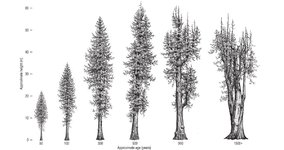pandacular
Masterpiece
In the United States, there are many federal and state agencies dedicated to the public study of natural resources. Every state has a Department of Natural Resources, which publish research papers about the forests, geology, wildlife, and much more in the state. I’m sure that other countries have the same.
I don’t think that these papers are widely read outside of industry professionals, but they should be! Many of these papers are written for the non-academic public, and are fascinating and full of things that will help you understand your environment.
Some can even help us better understand our bonsai. One such paper—which I saw mentioned on here—is titled Identifying Old Growth Forests in Western Washington by Robert Van Pelt and the Washington DNR. This paper features this beautiful illustration.

I would like this thread to be a place to share and discuss papers like, published by government, university, or NGOs on the natural environment and especially (of course) trees.
I don’t think that these papers are widely read outside of industry professionals, but they should be! Many of these papers are written for the non-academic public, and are fascinating and full of things that will help you understand your environment.
Some can even help us better understand our bonsai. One such paper—which I saw mentioned on here—is titled Identifying Old Growth Forests in Western Washington by Robert Van Pelt and the Washington DNR. This paper features this beautiful illustration.

I would like this thread to be a place to share and discuss papers like, published by government, university, or NGOs on the natural environment and especially (of course) trees.
